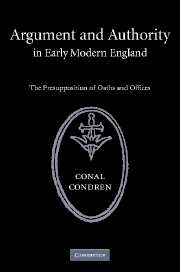Book contents
- Frontmatter
- Contents
- Preface
- Introduction
- Part I The liquid empire of office
- Part II The authority and insolence of office
- Part III ‘I, A. B.’
- 11 An overview of the oath in seventeenth-century argument
- 12 Coronation oaths
- 13 The oath of allegiance of 1606
- 14 Engagement with a free state
- 15 The oath of allegiance and the Revolution of 1688–9
- Epilogue
- Bibliography
- Index
15 - The oath of allegiance and the Revolution of 1688–9
from Part III - ‘I, A. B.’
Published online by Cambridge University Press: 28 October 2009
- Frontmatter
- Contents
- Preface
- Introduction
- Part I The liquid empire of office
- Part II The authority and insolence of office
- Part III ‘I, A. B.’
- 11 An overview of the oath in seventeenth-century argument
- 12 Coronation oaths
- 13 The oath of allegiance of 1606
- 14 Engagement with a free state
- 15 The oath of allegiance and the Revolution of 1688–9
- Epilogue
- Bibliography
- Index
Summary
… and from the mouth of England
Add thus much more, that no Italian priest
Shall tithe or toll in our dominions …
So tell the Pope, all reverence set apart
To him and his usurp'd authority.
(Shakespeare, King John 3.1)Throughout the seventeenth century, ritualised winter bonfires kept the Gunpowder Plot bright in the minds of English Protestants, and in 1688 they were barely cooling to grey embers when James II's reign itself crumbled into ashes. The son of Orange, with guns and printing press, had arrived on a Protestant wind, landing at Torbay on the anniversary of ‘gunpowder treason day’. As the semiotically attuned Gilbert Burnet remarked, this was of ‘good effect on the minds of the English nation’. William moved cautiously towards London. An Association was formed to make his gradually swelling support more than ‘a rope of sand’. By December, he was encamped at the tutti-man town of Hungerford. There were riots in London. James's daughter Anne fled to her co-religionists, his wife to France. The king followed in disguise, consigning the great seals of government to the Thames. But he was taken, returned to London and given a perplexingly popular welcome. This confusion of movement complicated any uncontentious account of his fall.
His initial flight was an ‘earthquake’ for his allies; his capture made it difficult to determine how he should be treated. Had he deserted the throne, or had his rights been usurped?
- Type
- Chapter
- Information
- Argument and Authority in Early Modern EnglandThe Presupposition of Oaths and Offices, pp. 314 - 342Publisher: Cambridge University PressPrint publication year: 2006

